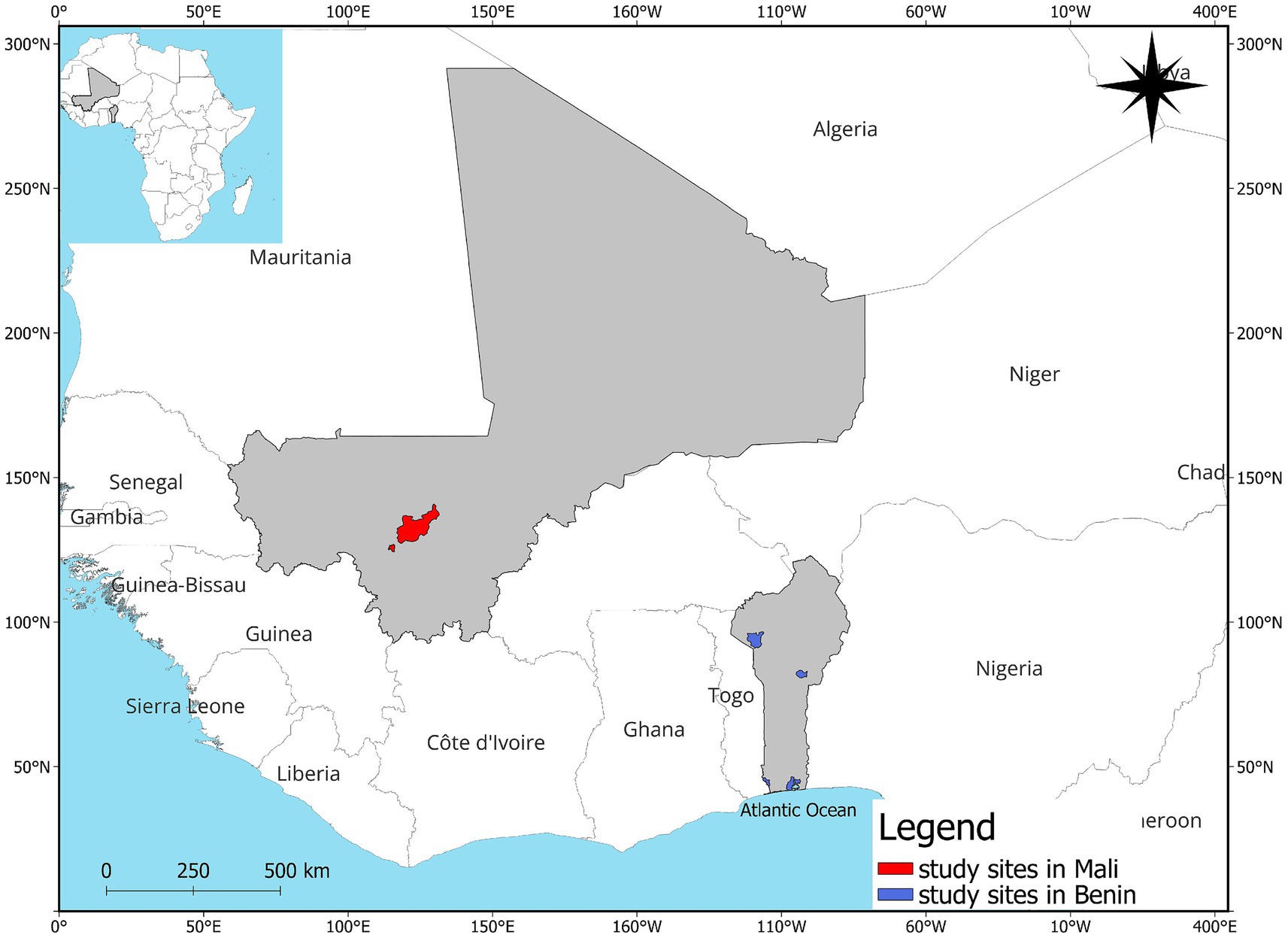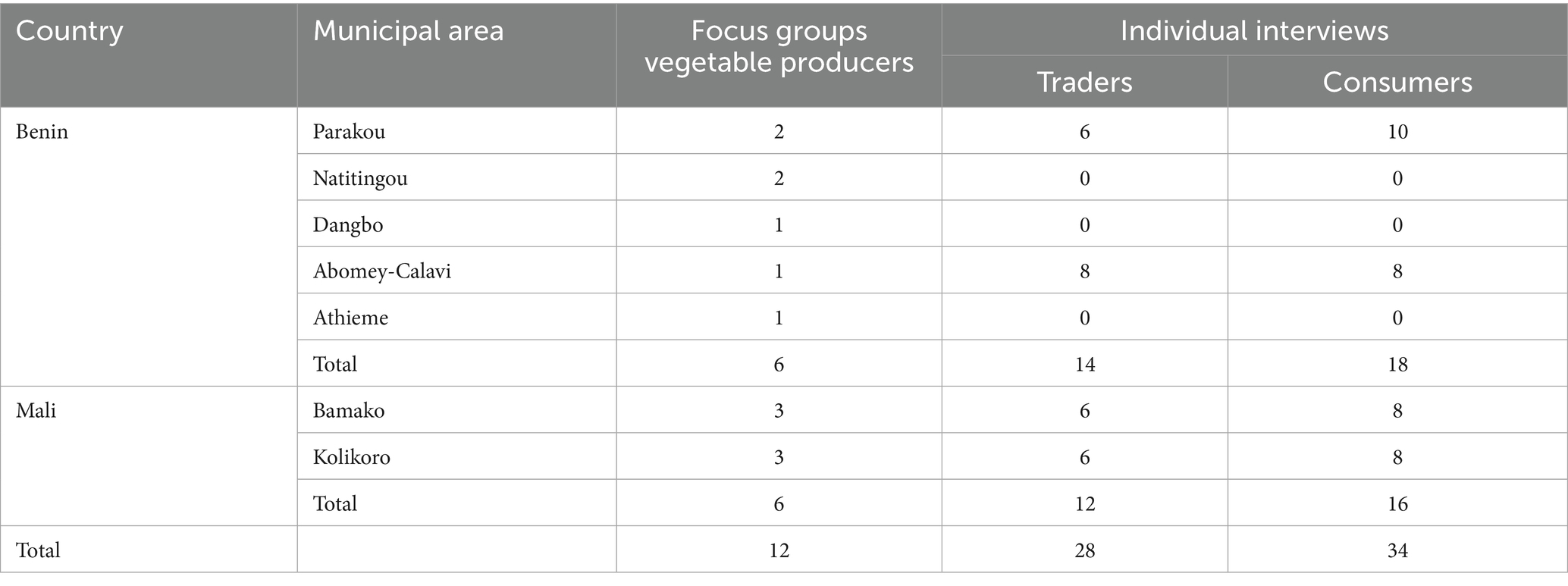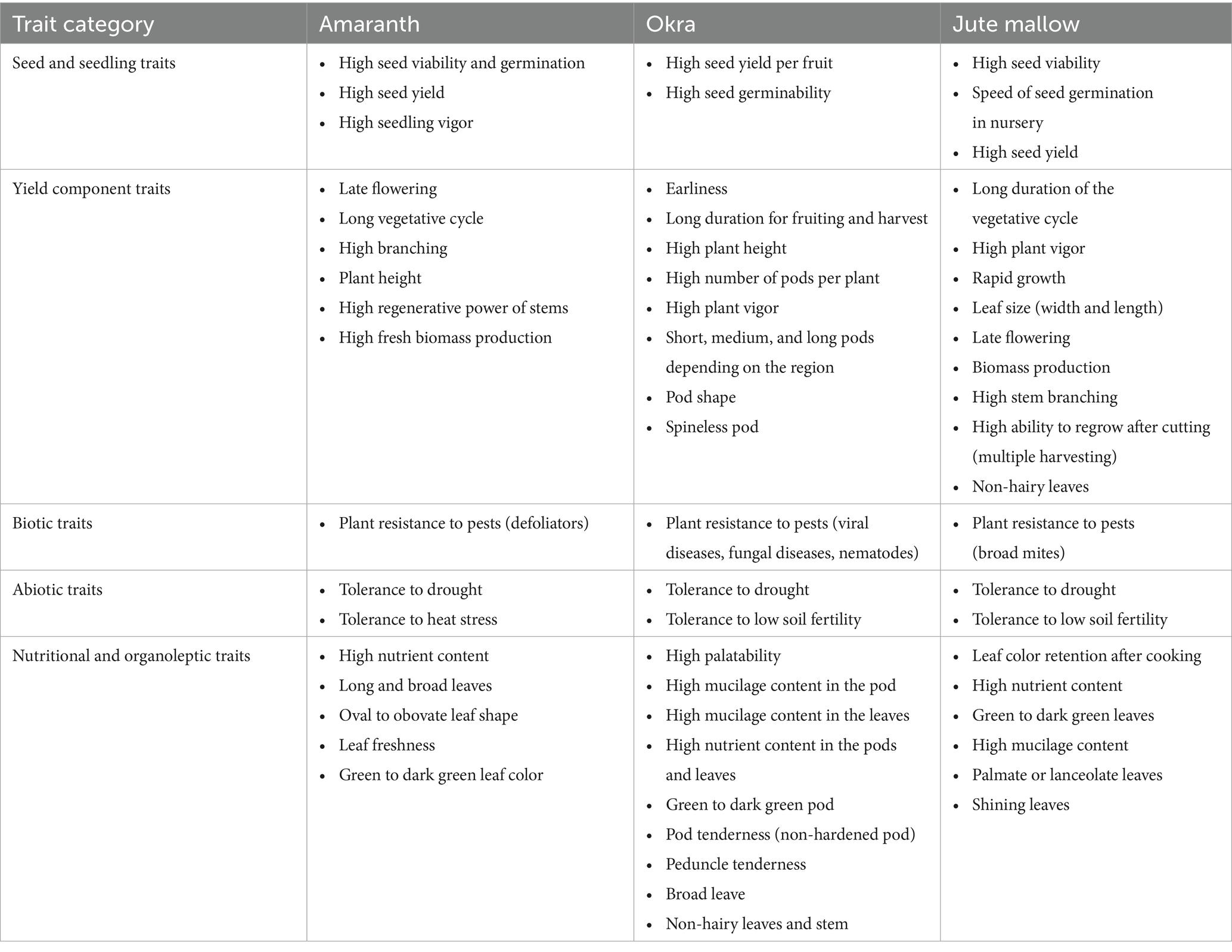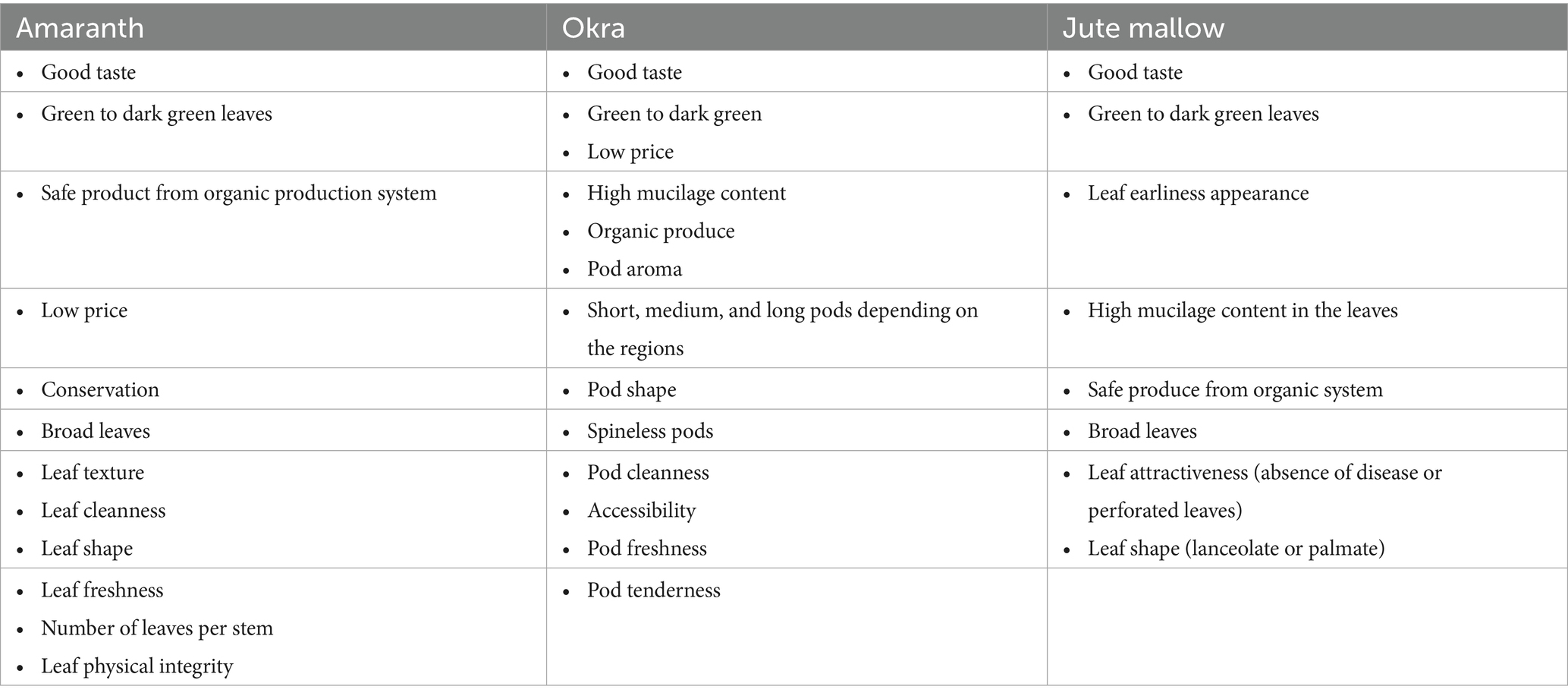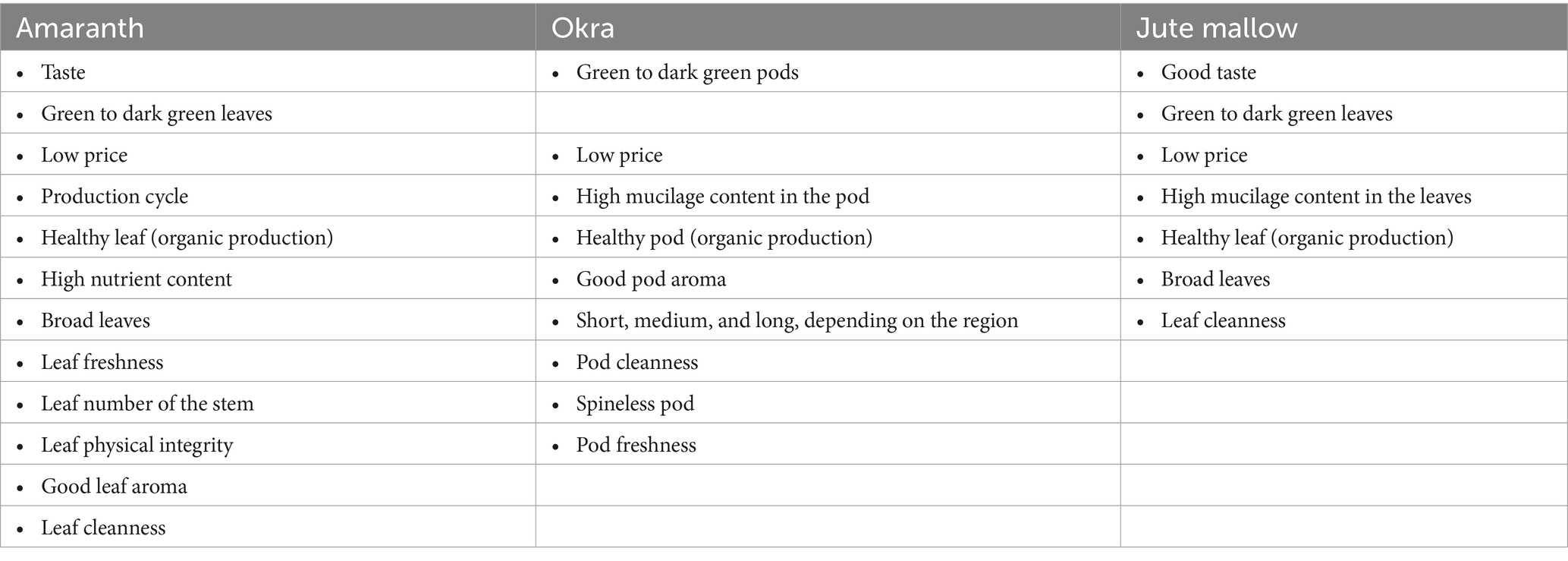- 1World Vegetable Center, West and Central Africa (WCA), Cotonou, Benin
- 2Faculté d’Agronomie, Université de Parakou, Parakou, Benin
- 3World Vegetable Center, Eastern and Southern Africa, Arusha, Tanzania
- 4Laboratory of Nutrition and Food Sciences, University of Abomey-Calavi, Abomey-Calavi, Benin
- 5World Vegetable Center, East and Southeast Asia, Bangkok, Thailand
Traditional African vegetables (TAV) are increasingly acknowledged for their potential to diversify smallholder farmers’ income and improve the quality of people’s diets. Plant breeding of TAV has been very limited, but this is slowly changing. Breeding programs need information on the crop trait preferences of value chain actors. Here, we identified and prioritized trait preferences for amaranth, jute mallow, and okra in Benin and Mali using focus group discussions with farmers and individual interviews with traders and consumers. The findings show that late flowering, a high number of branches, suitability for multiple harvesting, broad leaves, and green to dark green color are key traits farmers seek in amaranth and jute mallow. Tolerance to drought was a preferred trait among farmers for all three crops. Okra producers preferred early maturing varieties bearing a high number of fruits per plant. Regardless of the crop, traders and consumers had similar trait preferences. Leaf physical integrity, green to dark green, and broad leaves were priority traits for amaranth and jute mallow. In okra and jute mallow, high mucilage content was a key attribute. The trait preferences varied between different types of value chain actors, but were consistent for the same types of actors across locations. This research provides foundational information for plant breeders to develop market-preferred varieties, eventually contributing to the greater availability, acceptability, and affordability of TAV.
1 Introduction
Sub-Saharan Africa (SSA) faces a triple burden of malnutrition characterized by the coexistence of undernutrition, overweight, and micronutrient deficiencies. In 2022, the prevalence of stunting, wasting, and obesity among children under 5 years was 31.3% (59.4 million), 5.7% (10.3 million), and 3.7% (6.6 million), respectively (UNICEF et al., 2023). Micronutrient deficiencies are widespread in SSA. Low vegetable intake is a key contributing factor to micronutrient deficiencies. SSA has the lowest per capita vegetable consumption (and production) of all regions in the world (Kalmpourtzidou et al., 2020). For instance, in Benin and Mali, the average daily per capita vegetable consumption is estimated at 107 and 157 g, respectively (Micha et al., 2015), well below the WHO recommendation of three portions, or approximately 240 g per adult per day (WHO and FAO, 2003). Sufficient consumption of a diversity of vegetables is recognized as an essential pillar of a healthy diet (Micha et al., 2015; Guzek et al., 2022; Wongnaa et al., 2024). Vegetables are rich sources of vitamins, minerals, and dietary fibres. Besides global vegetables like tomatoes, peppers, and onions, Africa has a wealth of traditional vegetables.
Traditional African vegetables (TAV) are defined as “Plant species that are indigenous or naturalized to Africa, well adapted to or selected for local conditions, whose plant parts are used as a vegetable, and whose modes of cultivation, collection, preparation, and consumption are deeply embedded in local cuisine, culture, folklore, and language” (Towns and Shackleton, 2018). Compared to exotic or global vegetables, TAV are generally rich in micronutrients and antioxidants (Uusiku et al., 2010). TAV also contribute to crop diversification and dietary diversity (Afari-Sefa et al., 2016; Kansiime et al., 2018a, 2018b; Ochieng et al., 2018), have short growth cycles, and are amenable to production in urban and peri-urban areas (Ojiewo et al., 2015). TAV are also important sources of income for women who are involved in their production, marketing, and processing (Dinssa et al., 2016; Mwadzingeni et al., 2021). Despite their importance, TAV have not benefited from significant investment in breeding and seed system development, which limits farmers’ access to high-quality seed of improved varieties, resulting in suboptimal productivity (Ayenan et al., 2021; Croft et al., 2018). While TAV are reported to be adapted to local conditions and climate-resilient (World Vegetable Center and African Union Commission, 2024), the increasing demand for these vegetables requires the development of more productive and market-preferred varieties. Trait preferences significantly influence the desirability of vegetables, particularly in TAV (Merchant et al., 2022).
Breeding improved TAV varieties requires market information on farmers’ and consumers’ preferences, which is lacking, particularly on consumer preferences, as previous studies focused on farmers’ preferences. For instance, Gbèdolo et al. (2018) and Kouévi et al. (2023) identified the preferred traits of farmers in jute mallow, amaranth, okra, and other TAV in Benin, while Sugri et al. (2015) and Ibitoye and Kolawole (2022) mapped the preferred traits of farmers in okra in Ghana and Nigeria, respectively. These studies provide valuable data to inform breeding programs. However, they did not cover other important value chain actors, including traders and consumers. Identifying trait preferences among traders and consumers is crucial for a comprehensive understanding of traits of interest in breeding programs, ensuring a higher uptake of improved varieties.
Given this background, the objective of this study was to describe trait preferences of diverse value chain actors for selected TAV in Benin and Mali and identify entry points for breeders to develop varieties matching these preferences. We focused on three commonly consumed TAV rich in micronutrients and with a high potential to become economically important crops: amaranth (Amaranthus spp.), okra (Abelmoschus esculentus), and jute mallow (Corchorus olitorius).
2 Materials and methods
2.1 Study sites
The main TAV production sites in Benin and Mali were identified based on the authors’ experiences and the recommendations of agricultural extension officers. Data were collected by interviewing farmers, traders, and consumers. In Benin, the study covered southern Benin, including the municipalities of Dangbo (N6°30′0″, E2°31′0″), Athieme (N6°34′0″, E1°40′0″), and Abomey-Calavi (N6°26′24″, E2°20′24″) and northern Benin, including the municipalities of Parakou (N9°21′0″, E2°37′0″) and Natitingou (N10°10′0″, E1°23′00″). In Mali, the study was carried out in Bamako (ACI-2000, Taliko; N12°39′00″, E8°00′00″) and Koulikoro (Farakan, Baguinda Camp; N12°51′00″, E7°33′00″). Figure 1 shows the study sites.
2.2 Data collection and analysis
The study relied on qualitative research methods. We employed a snowball technique to identify TAV farmers, traders (including retailers and food vendors), and consumers along the value chain. Extension officers introduced the researchers to farmer associations producing TAV. The farmers connected us to traders, and the traders connected us to consumers and other traders. Data were collected during July and August 2022. The study plan was reviewed by the Institutional Biosafety and Research Ethics Committee (IBREC) of the World Vegetable Center (Registration No. 2022-014, dated 13 June 2022). Respondents gave written informed consent to participate in this study.
Focus group discussions (FGDs) were conducted with vegetable farmers, while individual in-depth interviews (IDIs) were carried out with traders and consumers. FGDs involved 5 to 9 participants, of whom about half were women. IDIs were used to interview traders because of their reluctance to share information in a group. For consumers, interviews were conducted at the household level, primarily engaging with mothers or housekeepers purchasing and cooking vegetables. The interview guides for the FGDs and IDIs consisted of three sections: participants’ perceptions of their knowledge, their consumption and the benefits of TAV, a listing of preferred traits with descriptions, and the priority-setting exercise. The interviews began with a session to create a comprehensive list of all traits. Next, each participant was asked to choose the five most important traits. These lists of five traits were then discussed in the group. After the discussion, participants voted on the order of the traits. The discussion and eventual ranking were recorded as part of the data collection. The same prioritization process was carried out for each crop.
Four trained enumerators in each country collected the data. In total, 12 FGDs were conducted with vegetable producers, 28 interviews with traders, and 34 interviews with consumers (Table 1). We continued group discussions and interviews until we reached a point of data saturation at which no new information emerged from additional interviews (Hennink and Kaiser, 2022).
3 Results
3.1 Perceived benefits of TAV among value chain actors
Respondents reported that TAV like okra, jute mallow, and amaranth provide economic, nutritional, medicinal, and social benefits. Farmers are well-informed about the diversity of TAV. They view TAV as low-input crops that yield a quick return on investment due to their short production cycles. The increasing market demand for amaranth, jute mallow, and okra has prompted farmers to increase their production. Both traders and farmers see TAV as a crucial source of income and employment.
Consumers recognized TAV as a vital part of their diet, providing essential micronutrients such as iron, calcium, potassium, magnesium, and various vitamins. Most emphasized the nutritional and medicinal benefits of fruits and vegetables in general. Respondents viewed vegetables as protective foods and understood their health benefits, including improved eyesight and a reduced risk of disease, as well as the strengthening of the immune system. They identified three main benefits of vegetables: (i) nutritional: being dense in iron, supporting children’s growth, preventing anemia and being high in vitamins and fiber; (ii) medicinal: being rich in antioxidants, aiding digestion, treating infections and preventing or curing diseases such as typhoid fever and hemorrhoids; and (iii) economical: being easy to access and affordable.
Some statements illustrate Beninese consumers’ perceptions regarding the benefits of vegetables, such as “Vegetables provide a lot of blood to humans,” which refers to the rich iron content of vegetables, and “Jute mallow leaves are often used to treat typhoid fever and hemorrhoids.” These statements are based on consumers’ experiences and perceptions.
3.2 Trait preferences of farmers, traders, and consumers
At the farmer level, the identified traits (Table 2) include seed and seedling characteristics (e.g., seed viability, germination and seed yield), yield components (e.g., leaf size, pod size and number of branches), and nutritional and organoleptic qualities (e.g., taste of amaranth leaves and mucilage content for jute mallow leaves and okra pods). In Benin and Mali, okra leaves are also consumed, and the key quality factors evaluated for these leaves include high mucilage content, large leaf size, and minimal or no hairiness.
A respondent in the Koutiala Region of Mali stated: “In our region of Koutiala, we usually eat okra leaves. Once harvested, we pound the leaves along with some parts of the stems. After pounding, the lignified parts are removed and the rest is used to make a delicious sauce.”
In amaranth, leaf quality—including color, ranging from green to dark green, and broad leaves —was also identified as an important trait by farmers. In leafy vegetables (amaranth and jute mallow), traits such as high branching, suitability for multiple harvesting (the ability of the stem to regenerate after cutting), and late flowering were highly desirable. In okra, early pod setting and a long duration of pod harvest were strongly preferred.
The preferred traits of traders were similar in Benin and Mali for the three target crops (Table 3). Overall, traders listed a larger number of preferred traits than farmers. Traders’ trait preferences for all crops were primarily related to organoleptic attributes (e.g., texture, flavor) as well as production systems (organic, conventional) (Table 3). Consumers prioritized organoleptic qualities, affordability (low price), leaf attractiveness (absence of disease or perforated leaves), color, and freshness of leaves and pods (Table 4). The comprehensive list of traits identified by farmers, traders, and consumers revealed the priority traits.
3.3 Priority-setting of trait preferences
Figure 2 presents the top five preferred traits for each category of actors and each target vegetable. Farmers’ priority trait preferences focused on agronomic factors (seed germination, duration of the vegetative cycle, yield, pest resistance, etc.) and climatic factors (drought tolerance). These traits are crucial for maintaining steady yields and facilitating easy cultivation. Traders prioritize the marketability of produce, which encompasses leaf attractiveness (absence of disease or perforated leaves), quality assurance such as organic or agroecological production, and sensory characteristics that enhance the product’s visual appeal. Consumers prioritize the overall quality of the products they purchase, which is reflected in factors such as freshness, visual appeal, and taste, along with an increasing interest in organic or safe products (Figure 2).
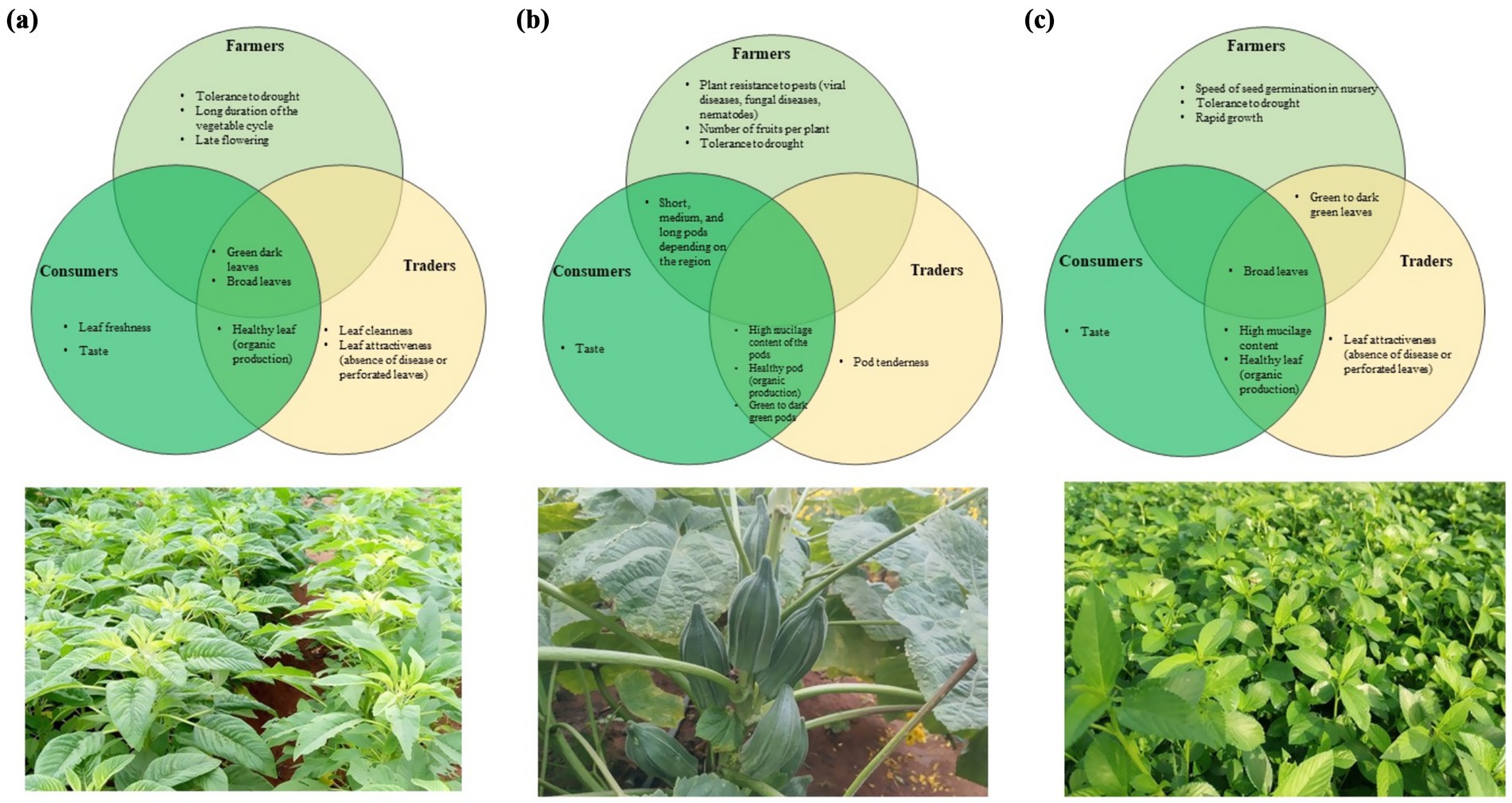
Figure 2. Venn diagram of (a) amaranth, (b) okra, and (c) jute mallow traits preferences among farmers, traders, and consumers.
In the case of amaranth and jute mallow, broad leaf size and green to dark green color are identified as preferred traits, while pod size and color represent common attributes. There is some overlap between traders’ and consumers’ priorities, such as the importance of organic or agroecological production and the value placed on flavor. However, characteristics valued by farmers, such as long vegetative cycles or early seed germination, often differ from those that consumers prioritize. These differences point at the importance of including the perspectives of multiple value chain actors in setting breeding priorities.
4 Discussion
4.1 Study strengths and limitations
The unique value of our approach lies in the fact that we collected comparable data from farmers, traders, and consumers for three traditional vegetables across two countries. Our approach relies on qualitative data; we did not use metrics or benchmarks to quantify people’s trait preferences. Moreover, the study did not analyze the heterogeneity of trait preferences within groups, for instance, the association between socioeconomic and demographic variables and preferences. Complementing the current study with a quantitative preference elicitation will provide comprehensive information for developing and promoting preferred varieties. Another limitation is the snowball sampling method used to identify farmers, traders, and consumers along the TAV value chain, which may result in a sample not fully representative of these value chain actors. Despite these limitations, the study provides useful information on preferred traits to guide TAV breeding programs, which is important as such information is lacking.
4.2 Stakeholders’ perceptions of the importance of TAV
Farmers held a positive view of the importance of vegetables. Similar findings emerged in Tanzania, where farmers’ perceptions of the nutritional value of TAV were a key factor in their integration into farming systems (Afari-Sefa et al., 2016; Kansiime et al., 2018a, 2018b; Ochieng et al., 2018). Respondents’ views on the nutritional benefits of TAV and the health advantages of vegetable consumption confirm other studies that have shown African leafy vegetables to be rich in nutrients and health-promoting bioactive compounds (Moyo et al., 2020; Mwadzingeni et al., 2021). Vegetables play a significant role in the human diet worldwide, contributing essential vitamins, minerals, dietary fiber, and phytochemicals (Yang et al., 2013; Mitchodigni et al., 2017a; WHO, 2021). In addition to their nutritional benefits, consumers highlighted the health or sanitation aspects of vegetables as key traits influencing their purchasing motivation. Perceptions of farmers, consumers, and traders can be utilized to enhance the consumption of TAV through social behavior change communication tools. A study in Benin showed a low intake of leafy vegetables, and that jute mallow is the preferred leafy vegetable fed to infants during the complementary feeding period (Mitchodigni et al., 2017a, 2017b). TAV have considerable potential to diversify agricultural systems and diets, which is essential for addressing the challenges of climate change (van Zonneveld et al., 2020). In a region where the consumption of micronutrient-rich crops is already low, TAV can help bridge the nutritional intake gap (Okigbo and Anyaegbu, 2021).
4.3 Breeding implications of trait preferences
The priorities assigned to crop attributes depend on various factors, including cultural, socioeconomic, and agroecological considerations (Weltzien et al., 2019). Farmers stress the importance of agronomic performance traits that define successful crop establishment, such as seed germination, seedling vigor, and yield, alongside abiotic traits like drought and heat stress tolerance and biotic traits such as pest resistance. Combining tolerance to biotic and abiotic stresses with horticultural traits and seed production traits is essential for developing preferred varieties, which can enhance variety adoption.
This study provides insight into market segmentation for target crops. For instance, the okra market can be broadly divided into two categories: dual-purpose okra varieties (grown for leaves and pods) for northern Benin and Mali, and okra for fresh pods in southern and central Benin. Based on preferences for okra leaf consumption, this segmentation provides valuable insights into selecting leaf quality traits (color, hairlessness, tenderness) to meet consumers’ demands in the dual-purpose okra segment. While this study outlines trait preferences among farmers, traders, and consumers in amaranth, jute mallow, and okra, it does not capture the specific preferences of various socioeconomic groups.
Identifying preferred traits is crucial for successfully introducing varieties, as it guides the breeding of those that fulfill stakeholders’ needs (Donovan et al., 2022; Voss et al., 2024). Our findings revealed that consumers in West Africa would favor an okra variety with high mucilage content (Ahiakpa et al., 2014; Agbenorhevi et al., 2020; Ibitoye and Kolawole, 2022). In amaranth and jute mallow, late flowering was a valuable trait for farmers, enabling them to harvest high-quality leaves over a relatively extended period. However, late flowering can negatively affect seed production and increase seed costs (Dinssa et al., 2018). Paradoxically, farmers cited seed yield as an important trait, indicating that breeders should make a trade-off between prolonged biomass harvest due to late flowering and seed productivity traits during the breeding of jute mallow and amaranth to ensure cost-efficient seed production and affordable seeds for farmers. Developing varieties that combine moderate seed yield, high vegetable yield, and preferred leaf quality attributes is essential to increase uptake. This can be achieved by combining early-flowering and high-seed-yield parental lines with those that exhibit late-flowering and high fresh biomass yield to develop base populations for selection. A better understanding of the genetic correlation between biomass yield and seed production will inform the choice of the most suitable selection method. The priority traits identified for each crop in this study can be essential in defining or refining target product profiles for jute mallow, amaranth, and okra. The product design process, during which target product profiles for specific market segments are defined, presents an opportunity to prioritize traits and make trade-offs based on what is biologically feasible, considering available genetic diversity and access to breeding technologies and infrastructure.
Not all traits listed by stakeholders can be improved through breeding. The frequent mention of “healthy” produce associated with organic or agroecological production among traders and consumers may indicate a shift in the market towards more nutritious and eco-friendly options. By identifying and understanding these criteria, stakeholders can effectively convey the advantages of specific crop varieties. For instance, farmers might be motivated to implement practices that improve traits appreciated by traders and consumers, which could result in higher market prices. A locally adapted certification and labeling may be required for farmers to fetch a premium.
5 Conclusion
This study employed a qualitative research approach to identify and prioritize trait preferences for three traditional African vegetables—amaranth, jute mallow, and okra—in Benin and Mali. Participants were well aware of the importance of vegetables in general and TAV in particular. The trait preferences varied among value chain actors but were similar for the same type of actors across locations. Regardless of the crop, the attributes preferred by traders and consumers were similar. The priority traits identified in this study can be considered essential for defining or refining target product profiles in jute mallow, amaranth, and okra. The variation in trait preferences along the value chain underscores the importance of strengthening the connection between the demand and supply sides in the breeding process.
Data availability statement
The original contributions presented in the study are included in the article/supplementary material, further inquiries can be directed to the corresponding author.
Ethics statement
The study plan was reviewed by the Institutional Biosafety and Research Ethics Committee (IBREC) of the World Vegetable Center (Registration No. 2022-014, dated 13 June 2022). The participants provided written informed consent to participate in this study.
Author contributions
IM: Writing – original draft, Writing – review & editing. MA: Writing – original draft, Writing – review & editing. BG: Writing – review & editing. SN'D: Funding acquisition, Writing – review & editing, Project administration. CK: Writing – review & editing. RB: Writing – review & editing. SC: Writing – review & editing. PS: Writing – review & editing.
Funding
The author(s) declare that financial support was received for the research and/or publication of this article. This work received financial support from the German Federal Ministry for Economic Cooperation and Development (BMZ) commissioned and administered through the Deutsche Gesellschaft für Internationale Zusammenarbeit (GIZ) Fund for International Agricultural Research (FIA), grant number 81260859. Funding was also received from the CGIAR Research Initiative on Fruit and Vegetables for Sustainable Healthy Diets supported by contributors to the CGIAR Trust Fund (https://www.cgiar.org/funders). We also acknowledge the support of core funders to the World Vegetable Center: Taiwan, United Kingdom, United States, Australia, Germany, Thailand, Philippines, South Korea, and Japan.
Conflict of interest
The authors declare that the research was conducted in the absence of any commercial or financial relationships that could be construed as a potential conflict of interest.
Generative AI statement
The authors declare that no Gen AI was used in the creation of this manuscript.
Publisher’s note
All claims expressed in this article are solely those of the authors and do not necessarily represent those of their affiliated organizations, or those of the publisher, the editors and the reviewers. Any product that may be evaluated in this article, or claim that may be made by its manufacturer, is not guaranteed or endorsed by the publisher.
References
Afari-Sefa, V., Rajendran, S., Kessy, R. F., Karanja, D. K., Musebe, R., Samali, S., et al. (2016). Impact of nutritional perceptions of traditional African vegetables on farm household production decisions: a case study of smallholders in Tanzania. Exp. Agric. 52, 300–313. doi: 10.1017/S0014479715000101
Agbenorhevi, J. K., Kpodo, F. M., Banful, B. K., Oduro, I. N., Abe-Inge, V., Datsomor, D. N., et al. (2020). Survey and evaluation of okra pectin extracted at different maturity stages. Cogent Food Agric. 6:1760476. doi: 10.1080/23311932.2020.1760476
Ahiakpa, J., Amoatey, H., Amenorpe, G., Apatey, J., Ayeh, E., and Agbemavor, W. (2014). Mucilage Content of 21 accessions of Okra (Abelmoschus spp L.). Scientia Agriculturae 2, 96–101. doi: 10.15192/PSCP.SA.2014.2.2.96101
Ayenan, M. A. T., Aglinglo, L. A., Zohoungbogbo, H. P. F., N’Danikou, S., Honfoga, J., Dinssa, F. F., et al. (2021). Seed systems of traditional African vegetables in eastern Africa: a systematic review. Front. Sustain. Food Syst. 5:689909. doi: 10.3389/fsufs.2021.689909
Croft, M. M., Marshall, M. I., Odendo, M., Ndinya, C., Ondego, N. N., Obura, P., et al. (2018). Formal and informal seed systems in Kenya: supporting indigenous vegetable seed quality. J. Dev. Stud. 54, 758–775. doi: 10.1080/00220388.2017.1308487
Dinssa, F. F., Hanson, P., Dubois, T., Tenkouano, A., Stoilova, T., Hughes, J. A., et al. (2016). AVRDC–the world vegetable center’s women-oriented improvement and development strategy for traditional African vegetables in sub-Saharan Africa. Eur. J. Hortic. Sci. 81, 91–105. doi: 10.17660/eJHS.2016/81.2.3
Dinssa, F. F., Yang, R. Y., Ledesma, D. R., Mbwambo, O., and Hanson, P. (2018). Effect of leaf harvest on grain yield and nutrient content of diverse amaranth entries. Sci. Hortic. 236, 146–157. doi: 10.1016/j.scienta.2018.03.028
Donovan, J., Coaldrake, P., Rutsaert, P., Bänzinger, M., Gitonga, A., Naziri, D., et al. (2022). Market intelligence for informing crop-breeding decisions by CGIAR and NARES. Market Intelligence Brief Series 1. Montpellier: CGIAR.
Gbèdolo, A. E., Dassou, A. G., Dassou, H. G., Dossou Aminon, I., Omondi, B. A., and Dansi, A. (2018). Morphotype diversity of Corchorus olitorius and influence of agricultural practices on its potential major pest insects. Sci. Hortic. 239, 234–241. doi: 10.1016/j.scienta.2018.05.047
Guzek, D., Gła¸bska, D., Groele, B., and Gutkowska, K. (2022). Fruit and vegetable dietary patterns and mental health in women: a systematic review. Nutr. Rev. 80, 1357–1370. doi: 10.1093/nutrit/nuab007
Hennink, M., and Kaiser, B. N. (2022). Sample sizes for saturation in qualitative research: a systematic review of empirical tests. Soc. Sci. Med. 292:114523. doi: 10.1016/j.socscimed.2021.114523
Ibitoye, D. O., and Kolawole, A. O. (2022). Farmers’ appraisal on okra [Abelmoschus esculentus (L.)] production and phenotypic characterization: a synergistic approach for improvement. Front. Plant Sci. 13:787577. doi: 10.3389/fpls.2022.787577
Kalmpourtzidou, A., Eilander, A., and Talsma, E. F. (2020). Global vegetable intake and supply compared to recommendations: a systematic review. Nutrients 12:1558. doi: 10.3390/nu12061558
Kansiime, M. K., Karanja, D. K., Alokit, C., and Ochieng, J. (2018a). Derived demand for African indigenous vegetable seed: implications for farmer-seed entrepreneurship development. Int. Food Agribus. Manag. Rev. 21, 723–740. doi: 10.22434/IFAMR2017.0095
Kansiime, M. K., Ochieng, J., Kessy, R., Karanja, D., Romney, D., and Afari-Sefa, V. (2018b). Changing knowledge and perceptions of African indigenous vegetables: the role of community-based nutritional outreach. Dev. Pract. 28, 480–493. doi: 10.1080/09614524.2018.1449814
Kouévi, T. A., Adé, C. K., N’Danikou, S., Mongbo, R. L., Komlan, C., Dagnon, G. N., et al. (2023). Preferences of market gardeners for traditional vegetables and associated factors in urban areas of southern Benin. doi: 10.17170/KOBRA-202307218422
Merchant, E. V., Odendo, M., Ndinya, C., Nyabinda, N., Maiyo, N., Downs, S., et al. (2022). Barriers and facilitators in preparation and consumption of African indigenous vegetables: a qualitative exploration from Kenya. Front. Sustain. Food Syst. 6:801527. doi: 10.3389/fsufs.2022.801527
Micha, R., Khatibzadeh, S., Shi, P., Andrews, K. G., Engell, R. E., and Mozaffarian, D. (2015). Global, regional and national consumption of major food groups in 1990 and 2010: a systematic analysis including 266 country-specific nutrition surveys worldwide. BMJ Open 5:e008705. doi: 10.1136/bmjopen-2015-008705
Mitchodigni, I. M., Amoussa Hounkpatin, W., Ntandou-Bouzitou, G., Avohou, H., Termote, C., Kennedy, G., et al. (2017a). Complementary feeding practices: determinants of dietary diversity and meal frequency among children aged 6–23 months in southern Benin. Food Secur. 9, 1117–1130. doi: 10.1007/s12571-017-0722-y
Mitchodigni, I., Hounkpatin, W., Ntandou-Bouzitou, G., Termote, C., Kennedy, G., and Hounhouigan, D. (2017b). Complementary feeding practices of children aged 6-23 months in rural area, southern-Benin: challenges and opportunities. Int. J. Trop. Dis. Health 24, 1–12. doi: 10.9734/IJTDH/2017/33877
Moyo, S. M., Serem, J. C., Bester, M. J., Mavumengwana, V., and Kayitesi, E. (2020). African Green Leafy Vegetables Health Benefits Beyond Nutrition. Food Reviews International, 37, 601–618. doi: 10.1080/87559129.2020.171751
Mwadzingeni, L., Afari-Sefa, V., Shimelis, H., N’Danikou, S., Figlan, S., Depenbusch, L., et al. (2021). Unpacking the value of traditional African vegetables for food and nutrition security. Food Secur. 13, 1215–1226. doi: 10.1007/s12571-021-01159-7
Ochieng, J., Afari-Sefa, V., Karanja, D., Kessy, R., Rajendran, S., and Samali, S. (2018). How promoting consumption of traditional African vegetables affects household nutrition security in Tanzania. Renew. Agric. Food Syst. 33, 105–115. doi: 10.1017/S1742170516000508
Ojiewo, C., Keatinge, D. J. D. H., Hughes, J., Tenkouano, A., Nair, R., Varshney, R., et al. (2015). The role of vegetables and legumes in assuring food, nutrition, and income security for vulnerable groups in sub-Saharan Africa. World Med. Health Policy 7, 187–210. doi: 10.1002/wmh3.148
Okigbo, R. N., and Anyagbu, C. F. (2021). Underutilized Plants of Africa. Journal of Biology and Nature 13:34–49. Available at: https://www.ikprress.org/index.php/JOBAN/article/view/6909
Sugri, I., Abdulai, M. S., Larbi, A., Hoeschle Zeledon, I., Kusi, F., and Agyare, R. Y. (2015). Participatory variety selection of okra (Abelmoschus esculentus L.) genotypes for adaptation to the semi-arid agro-ecology of northern Ghana. African J. Plant Sci. 9, 466–475. doi: 10.5897/AJPS2015.1340
Towns, A. M., and Shackleton, C. (2018). Traditional, indigenous, or leafy? A definition, typology, and way forward for African vegetables. Econ. Bot. 72, 461–477. doi: 10.1007/s12231-019-09448-1
UNICEF et al. (2023). Levels and trends in child malnutrition: UNICEF/WHO/World Bank Group joint child malnutrition estimates: key findings of the 2023 edition. New York: UNICEF and WHO.
Uusiku, N. P., Oelofse, A., Duodu, K. G., Bester, M. J., and Faber, M. (2010). Nutritional value of leafy vegetables of sub-Saharan Africa and their potential contribution to human health: a review. J. Food Compos. Anal. 23, 499–509. doi: 10.1016/j.jfca.2010.05.002
van Zonneveld, M., Turmel, M.-S., and Hellin, J. (2020). Decision-Making to Diversify Farm Systems for Climate Change Adaptation. Front. Sustain. Food Syst. 4:32. doi: 10.3389/fsufs.2020.00032
Voss, R. C., de Sousa, K., Shango, A., Amavi Aglinglo, L., Laporte, M.-A., Legba, E. C., et al. (2024). Citizen science informs demand-driven breeding of opportunity crops. BioRxiv. doi: 10.1101/2024.07.31.605211
Weltzien, E., Rattunde, F., Christinck, A., Isaacs, K., and Ashby, J. (2019). Gender and farmer preferences for varietal traits. Plant Breed. Rev 43, 243–278. doi: 10.1002/9781119616801.ch7
WHO (2021). Plant-based diets and their impact on health, sustainability and the environment: a review of the evidence: WHO European Office for the Prevention and Control of Noncommunicable Diseases. Copenhagen: WHO Regional Office for Europe.
WHO and FAO (2003). Diet, nutrition, and the prevention of chronic diseases: Report of a joint WHO/FAO expert consultation. Geneva, Switzerland: World Health Organization, 149.
Wongnaa, C. A., Tuffour, T., Asante, B. O., Adabah, R., and Agoalikum, P. (2024). Unlocking the potential of biofortified crops: economic determinants of orange flesh sweet potato adoption among smallholder farmers in Ghana. Cogent Food & Agriculture, 10. doi: 10.1080/23311932.2024.2415390
World Vegetable Center and African Union Commission. World Vegetable Center and African Union Commission, 2024. African Vegetable Biodiversity Rescue Plan (2025–2035), (2024). World Vegetable Center – Eastern and Southern Africa, Arusha, Tanzania. 45.
Keywords: amaranth, jute mallow, okra, Benin, Mali, crop improvement, opportunity crops
Citation: Mitchodigni IM, Ayenan MAT, Govoeyi B, N'Danikou S, Komlan C, Bouraima R, Codjo S and Schreinemachers P (2025) Variety trait preferences for traditional African vegetables in West Africa. Front. Sustain. Food Syst. 9:1613104. doi: 10.3389/fsufs.2025.1613104
Edited by:
Jörn Oliver Schmidt, WorldFish, MalaysiaReviewed by:
Ehab Awad-Allah Ibrahim, Horticulture Research Institute, EgyptSyed Riaz Ahmed, Pakistan Agricultural Research Council, Pakistan
Copyright © 2025 Mitchodigni, Ayenan, Govoeyi, N’Danikou, Komlan, Bouraima, Codjo and Schreinemachers. This is an open-access article distributed under the terms of the Creative Commons Attribution License (CC BY). The use, distribution or reproduction in other forums is permitted, provided the original author(s) and the copyright owner(s) are credited and that the original publication in this journal is cited, in accordance with accepted academic practice. No use, distribution or reproduction is permitted which does not comply with these terms.
*Correspondence: Irene M. Mitchodigni, aXJlbmUubWl0Y2hvZGlnbmlAd29ybGR2ZWcub3Jn
 Irene M. Mitchodigni
Irene M. Mitchodigni Mathieu A.T. Ayenan
Mathieu A.T. Ayenan Benoit Govoeyi2
Benoit Govoeyi2 Christelle Komlan
Christelle Komlan Pepijn Schreinemachers
Pepijn Schreinemachers